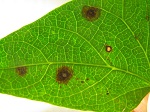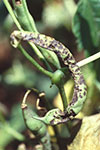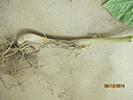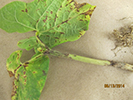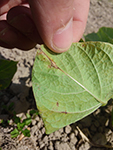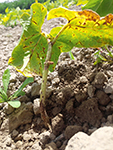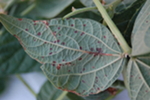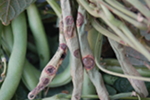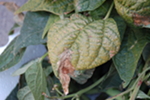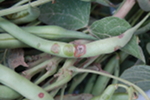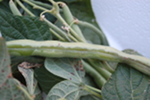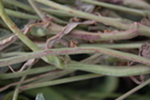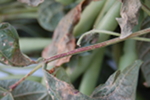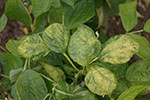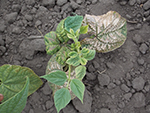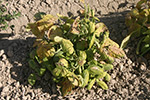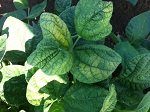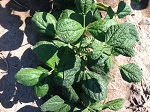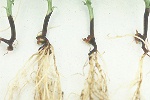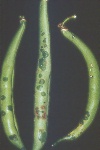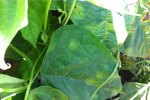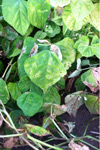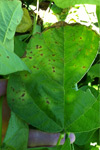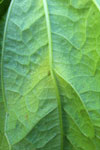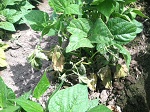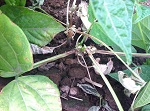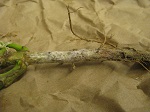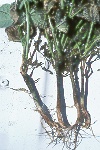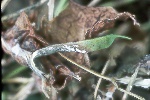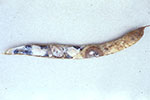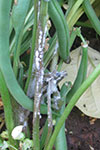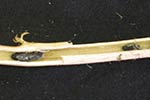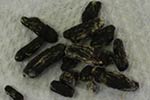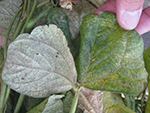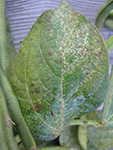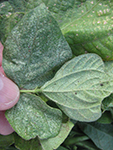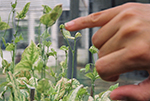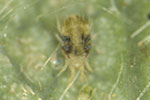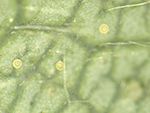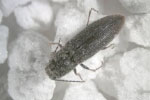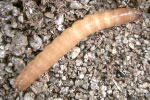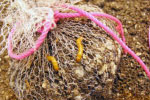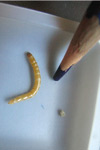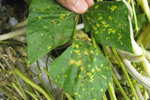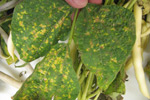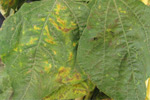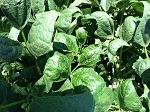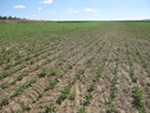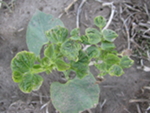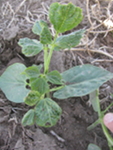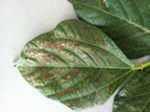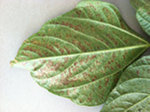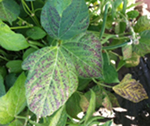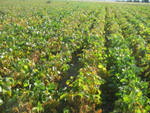Photo Gallery of Vegetable Problems
Bean
(Click on photo to enlarge)
Diseases
For those of you who work with bean crops of any kind (oilseed, cover, processing, fresh market, seed, forage, etc.), here is important and time-sensitive information from Victor Shaul of the WSDA Seed Program on proposed amendments to bean seed quarantine rules in WA.
Victor Shaul: "First off thank all of you that provided input and took your time coming to meetings on this important topic.
"The public hearing for the changes to the Bean Seed Quarantine was held on July 7th. Those in attendance were in favor of the proposed changes to the quarantine. The effective date of these changes is August 21, 2015.
"To re-cap the changes to the quarantine are:
· Bean seed fields under sprinkler irrigation will require three inspections with the option of laboratory testing for halo blight in lieu of the first inspection.
· The elimination of the Notice of Intent quarantine reporting form. This will be replaced with the requirement to attach proof of quarantine compliance with every phytosanitary or certified field inspection application.
"As previously discussed these changes come too late for this season, but I am really pleased at the number of field inspection applications that were submitted for this season that proactively implemented these methodologies.
"These changes will necessitate new application and inspection forms, so that will be an internal winter project and you will be provided with new applications to use at that time."
Please provide feedback or recommendations to:
Victor Shaul, WSDA Seed Program Manager
vshaul@agr.wa.gov
Further Info:
Proposed Bean Seed Quarantine Rule Amendments
Disease: Alfalfa mosaic
Pathogen: Alfalfa mosaic virus
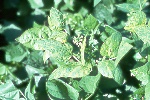 |
| Photo Source: G.Q. Pelter |
On-Line Resources:
Pacific Northwest Plant Disease Management Handbook: Bean, All (Phaseolus vulgaris) – Bean Common Mosaic, Oregon State University
Common name: Alternaria leaf and
pod spot
Cause: Alternaria species, including A. alternata (synonym
A. tenuis), A. brassicae f. phaseoli, and A.
brassicicola.
Host Crops: Various types of bean.
Online Resources:
Fungal Leaf Spots, Bean IPM, Legume ipmPIPE Diagnostic Series, H.F. Schwartz (Colorado State University) and S.K.Mohan (University of Idaho)
Alternaria Leaf and Pod Spot of Snap Bean in Florida, Shouan Zhang, Aaron J. Palmateer, Ken Pernezny, and R. T. McMillan, Jr., U.S. Department of Agriculture, UF/IFAS Extension Service, University of Florida, IFAS, Florida A & M University Cooperative Extension Program, and Boards of County Commissioners Cooperating. Nick T. Place, dean for UF/IFAS Extension.
Alternaria leaf spot of faba beans, Grains Research and Development
Corp., State Government of Victoria, AU.
Disease: Anthracnose
Pathogen: Colletotrichum lindemuthianum
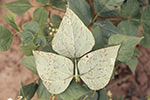 |
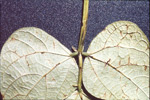 |
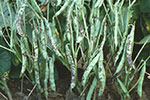 |
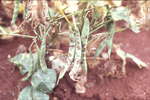 |
| Photo Source: Krishna Mohan, University of Idaho | |||
Disease: Bacterial brown spot
Pathogens: Pseudomonas syringae pv. syringae
Host crops: Bean crops (including snap beans, lima beans, and dry beans), vetch, and several leguminous weeds. Lima beans are more susceptible than snap green beans. Strains of
P. syringae that infect fruit crops do not cause brown spot on bean. The pathogen can be seedborne in bean.
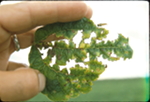 |
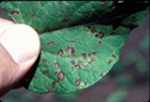 |
||
| Symptoms of brown spot on bean leaves caused by Pseudomonas syringae pv. syringae. | |||
| Photo Source: Phil Miklas, USDA ARS bean breeder | |||
Online Resources:
Bacterial Brown Spot, PNW Plant Disease Management Handbook, a Pacific Northwest Extension Publication
Bacterial Diseases of Beans, Fact Sheet Page 729.50, Date: 10-1991, Cornel University Vegetable MD On-line
Bacterial Brown Spot, How to Manage Pests, University of California Inetgrated Pest Management Guidelines.
Bacterial Diseases of Dry Edible Beans in the Central High Plains,
Plant Management Network
Disease: Bean common mosaic
Pathogen: Bean common mosaic virus (BCMV)
Online Resources:
Disease: Common bacterial blight
Pathogen: Xanthomonas axonopodis pv. phaseoli
Host crops: Edible beans crops and bean seed crops (including snap beans, lima beans, and dry beans)
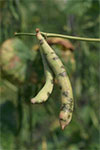 |
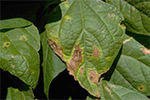 |
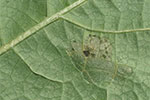 |
| Common bacterial blight on pods. | Mature common bacterial blight lesions. | Water-soaked lesions of common bacterial blight. |
| Photo Source: Howard F. Schwartz, Colorado State University | ||
On-Line Resources:
Common Bacterial Blight and Halo Blight: Two Bacterial Diseases of Phytosanitary Significance for Bean Crops in Washington State, Washington State University Extension Fact Sheet
Disease: Curly top
Pathogen: Beet curly top virus (BCTV), vectored by the beet leafhopper Circulifer tenellus
Host crops: Numerous plant species including many vegetables such as bean, beet, carrot, eggplant, coriander, pepper, potato, tomato, various cucurbits such as squash, cucumber, pumpkin, watermelon, etc.
 |
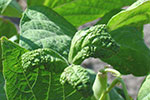 |
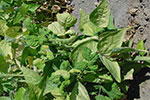 |
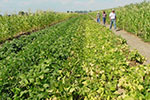 |
| Beet curly top virus on bean. | Symptoms of curly top virus of bean. | Symptoms of curly top virus of bean. | Symptoms of curly top virus of bean. |
| Photo Source: Phil Hamm | Photo Source: Lindsey J. du Toit | ||
On-Line Resources:
Pacific Northwest Plant Disease Management Handbook: Bean, All (Phaseolus vulgaris) – Curly Top
Curly Top Disease of Tomato, Plant Management Network International.
Disease: Fusarium root rot
Pathogen: Fusarium solani
Disease: Gray mold
Pathogen: Botrytis cinerea
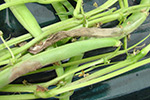 |
| Gray mold on Hercules garden beans. Note the watersoaked lesion on one bean pod, and brown-gray sporulation of Botrytis cinerea on a severely symptomatic bean pod. |
| Photo Source: Carrie H. Wohleb |
On-Line Resources:
Pacific Northwest Plant Disease Management Handbook: Bean, Snap (Phaseolus vulgaris) – Gray Mold
Pacific Northwest Plant Disease Management Handbook: Bean, Lima Phaseolus lunatas – Gray Mold
Disease: Halo blight
Pathogen: Pseudomonas syringae pv. phaseolicola
On-Line Resources:
Common Bacterial Blight and Halo Blight: Two Bacterial Diseases of Phytosanitary Significance for Bean Crops in Washington State, Washington State University Extension Fact Sheet
Halo Blight of Beans, Identification & Management of Emerging Vegetable Problems in the Pacific Northwest. Pacific Northwest Vegetable Extension Group.
Pacific Northwest Plant Disease Management Handbook: Bean, All (Phaseolus vulgaris) – Halo Blight
Disease: Pythium blight (also known as cottony leak or
Pythium leak)
Pathogen: Pythium species
Host Crops: When bean plants are under excessive irrigation, or
during cool and/or prolonged periods of moist conditions, Pythium spp. may
colonize the stems, branches, and even pods of bean plants, resulting in a
water-soaked rot of the affected tissues, accompanied by fluffy, white, aerial
mycelium of the pathogen. The disease may be mistaken for early stages of white
mold caused by Sclerotinia sclerotiorum, but microscopic examination readily
enables differentiation of the two diseases/pathogens.
Online Resources:
Bean, Dry (Phaseolus vulgaris)-Pythium Diseases {Pythium Blight}, Pacific Northwest Plant Disease Handbook.
Bean Diseases: Pythium Blight, University of Delaware Cooperative Extension.
Cultivar and Fungicide Effects on Pythium Leak of Snap Bean, Plant
Health Progress, Plant Management Network.
Disease: Pythium root rot
Pathogen: Pythium species
On-Line Resources:
Disease: White mold
Pathogen: Sclerotinia sclerotiorum
Host crops: Bean, various brassica vegetables, carrot, eggplant, lettuce, potato, tomato, etc.
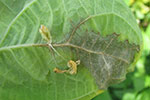 |
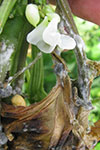 |
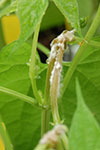 |
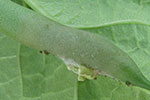 |
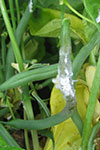 |
|
| Flower and leaf infection. | Sclerotia on flowers and stem. | Early pod infection. | Mycelium on pod. | ||
| Photo Source: Lindsey du Toit | Photo Source: Lyndon Porter |
Photo Source: Lindsey du Toit | |||
See Diseases, pests, and other problems common to many vegetables: White mold.
Insect/Mite Pests
Disease: Seedcorn maggot
Pathogen: Delia platura
Host Crops: Many vegetable crops including snap, kidney, and lima beans, onion, corn, turnip, pea, cabbage, and cucurbits. They cause the most damage in spring to newly emerging seedlings.
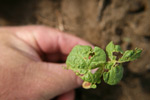 |
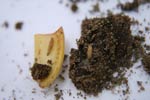 |
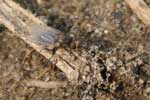 |
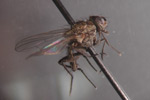 |
| Seedcorn maggot injury to bean leaves. | Seedcorn maggot larvae. | Seedcorn maggot fly on soil. | Seedcorn maggot fly. |
| Photo Source: Tim Waters, WSU Extension Educator for Benton and Franklin Counties | |||
On-Line Resources:
Pacific Northwest Insect Management Handbook: Vegetable crop pests – Seedcorn maggot
Seed Corn Maggot. VegEdge, University of Minnesota
Seed Corn Maggot. UMass Amherst
See Diseases, pests, and other problems common to many vegetables: Seedcorn maggot
Common name: Spider mites
Latin binomial: Tetranychus spp. including two-spotted spider mite (Tetranychus urticae), strawberry spider mite (Tetranychus turkestani), and Pacific spider mite (Tetranychus pacificus)
Host crops: Wide host range, including many vegetables such as bean, carrot, potato, etc.
Online Resources:
https://insect.pnwhandbooks.org/vegetable/vegetable-pests/hosts-and-pests/bean-dry-spider-mite
https://insect.pnwhandbooks.org/vegetable/vegetable-pests/hosts-and-pests/bean-lima-spider-mite
https://insect.pnwhandbooks.org/vegetable/vegetable-pests/hosts-and-pests/bean-snap-spider-mite
See also Diseases, pests, and other problems common to many vegetables: Spider mites.
Common name: Thrips, including western flower thrips, onion thrips, and other species.
Latin binomial: Various thrips including Frankliniella occidentalis (western flower thrips) and Thrips tabaci (onion thrips).
Host crops: Numerous plant species including many vegetables such as
basil,
broccoli,
cabbage,
cauliflower,
cucumber, onion,
potato,
pumpkin,
squash,
tomato and
watermelon.
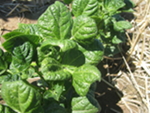 |
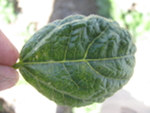 |
| Downward cupping of bean leaves and other leaf distortion as a result of severe thrips infestation. | |
| Photo Source: Lindsey du Toit, Washington State University | |
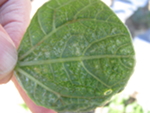 |
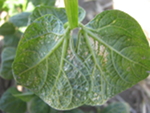 |
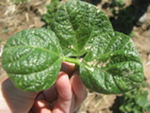 |
| Silvering/stippling and browning of veins on the lower bean leaf surface as a result of severe thrips feeding injury. | ||
| Photo Source: Lindsey du Toit, Washington State University | ||
Online Resources:
Pacific Northwest Insect Management Handbook. Chapter: Vegetable Crops, Section: Bean, dry.
Washington State University Hortsense.
Western Flower Thrips Thysanoptera: Thripidae Frankiniella occidentalis,
See Diseases, pests, and other problems common to many vegetables: Western flower thrips.
Common name (of damaging stage): Wireworm (adults are called click beetles or snapping beetles)
Latin binomial: Ctenicera spp. and Limonius spp. Several kinds of wireworms are in the Pacific Northwest. Wireworms causing the most damage in irrigated areas are the Pacific Coast wireworm (Limonius canus), the sugar beet wireworm (L. californicus), the western field wireworm (L. infuscatus), and the Columbia Basin wireworm (L. subauratus). The Pacific Coast and sugar beet wireworms are the most common. Where annual rainfall is <15 inches, the Great Basin wireworm (Ctenicera pruinina) may be a problem, especially when irrigated crops are grown on sagebrush or dry wheat land. This species usually disappears after a few years of irrigation, but may be replaced by Limonius spp. which are favored by moist conditions. West of the Cascades, other wireworm species are pests, including Agriotes spp.
Host crops: All crops are susceptible to wireworm, but this pest is most destructive on beans, carrot, corn, grain, onion, potatoes, spinach seed crops, and other annual crops in the PNW.
 |
 |
 |
|
| A click beetle of the species Agriotes obscurus, the larvae of which are wireworms. | A click beetle of the species Limonius californicus, the larvae of which are wireworms. | A click beetle of the species Limonius canus, the larvae of which are wireworms. | |
| Photo Source: Oregon State University – Oregon State Arthropod Collection. | |||
On-Line Resources:
Pacific NorthwestInsect Management Handbook: Vegetable crop pests – Wireworm
Managing Wireworms in Vegetable Crops. Ontario Ministry of Agriculture and Food
Wireworms. VegEdge, University of Minnesota.
Dry beans: Wireworms. UC IPM Online, University of California
Wireworm Field Guide - A guide to the identification and control of wireworms, Syngenta Crop Protection Canada, Inc.
Wireworm Biology and Nonchemical Management in Potatoes in the Pacific Northwest, N. Andrews, M. Ambrosino, G. Fisher, and S.I. Rondon, Pacific Northwest Extension Publication no. PNW607
See Diseases, pests, and other problems common to many vegetables: Wireworm
Abiotic Problems on Bean
Common name: Crumpled leaf or LCR
Cause: A genetic disorder or trait called crumpled leaf or LCR caused by an incompatible developmental reaction when beans from different centers of domestication are crossed, e.g., in crosses of Mesoamerican bush blue lake materials with Andean Midwestern types of beans.
Host Crops: Various types of beans resulting from crosses of different races of beans.
On-Line Resources:
Singh, S.P. and A. Molina. 1996. Inheritance of crippled trifoliolate leaves occurring in interracial crosses of common bean and its relationship with hybrid dwarfism. J. Hered. 87:464-469.
Herbicide Injury
Common name: Injury from various types of herbicides can result from drift, residual carryover in soil or planting material, excessive rates of application, overlap in applications, etc.
Cause: Various types of herbicides can cause injury to bean plants.
Host Crops: This depends on the specific herbicide. For example, most
broadleaf plants are susceptible to injury by 2,4-D.
Online Resources:
2,4-D- and Dicamba-tolerant Crops — Some Facts to Consider, Purdue University Extension
Herbicide Mode of Action and Injury Symptoms, University of Minnesota Extension Service
Air pollution/ozone injury
Common name: Air pollution
or ozone injury
Cause: During very hot conditions, combined with the presence of
excessive air particulate matter, e.g., from wildfires, symptoms of air
pollution and/or ozone injury have been observed in multiple bean fields in
central Washington, particularly in adzuki bean crops.
Host Crops: Various types of beans, but adzuki beans seem to be
particularly susceptible.
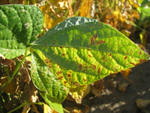 |
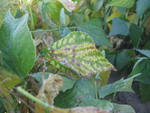 |
| Symptoms of air pollution and possible ozone injury in a bean crop. | |
| Photo Source: Lindsey du Toit, Washington State University | |
Online Resources:
Dry
Beans, University of California IPM Pest Management Guidelines
Ozone injury on beans, Cornell Univ. College of Agriculture and Life
Sciences, Vegetable Pathology.
Air
Pollution Effects on Vegetables, Gerald E. Brust, IPM Vegetable Specialist,
University of Maryland, 2007




